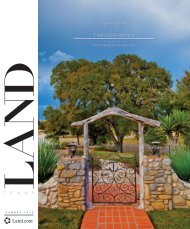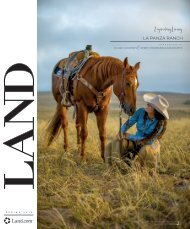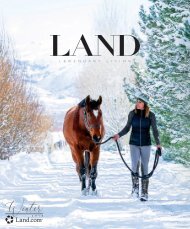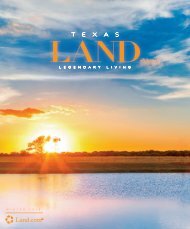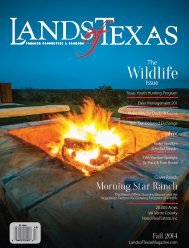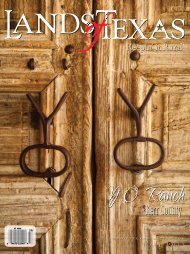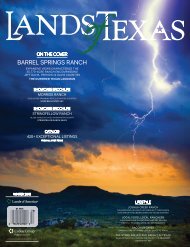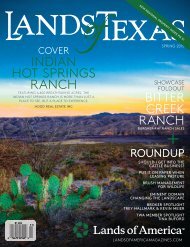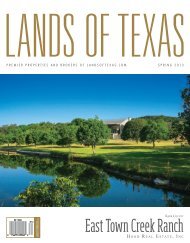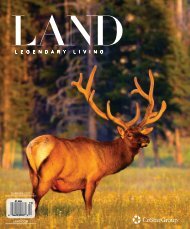Create successful ePaper yourself
Turn your PDF publications into a flip-book with our unique Google optimized e-Paper software.
Quail Sustainability<br />
WRITTEN BY ROBERT AND JANELLE FEARS<br />
One of the most avid and dedicated group of hunters in the<br />
entire state of <strong>Texas</strong> are those that pursue quail. Often their<br />
most cherished possession is one or more good dogs that flush<br />
coveys and retrieve birds after they have been shot. Addicted quail<br />
hunters will freely spend money to support their habit.<br />
Drs. Dale Rollins, a <strong>Texas</strong> A&M AgriLife Extension Service<br />
wildlife specialist at San Angelo, Jason Johnson, an AgriLife<br />
Extension economist at Stephenville and Kelly Reyna with the<br />
Department of Biological Science at the University of North <strong>Texas</strong><br />
in Denton conducted a quail hunter survey in 2000 and again in<br />
2011. Through the latter survey, it was learned that each hunter<br />
averaged spending about $8,606 for 8.8 days of quail hunting<br />
during the 2010–2011 season. Based on harvest estimates, the<br />
expenditures result in $253 per bagged bird.<br />
“The impact that these hunting expenditures have on quailhunting<br />
destination counties and communities is huge,” Johnson<br />
said. “The latest survey showed that 46 percent of quail hunting<br />
dollars are spent at the hunting destination with another 18 percent<br />
going to communities located between the hunter’s home and<br />
hunting site. These expenditures are for merchandise, hotels,<br />
restaurants, fuel and sales taxes.”<br />
This rosy scenario has a big black cloud over it, however.<br />
There is a lack of birds, especially during drought. Decline in<br />
bird populations severely threaten the ability of hunters to enjoy<br />
their pastime and the continued heightened economy of rural<br />
communities. A lot of research dollars, time, and talent are<br />
channeled toward solving this problem.<br />
Dr. Brad Dabbert, Burnett Foundation Endowed Professor<br />
of Quail Ecology at <strong>Texas</strong> Tech University, discussed upland<br />
game bird production during a recent Sustainable Rangelands<br />
Symposium in Lubbock. His presentation was largely based on<br />
results from his quail research funded by the Burnett Foundation<br />
and the Park Cities Chapter of the Quail Coalition. The remainder<br />
of this article contains quotes and information from Dr. Dabbert’s<br />
presentation. Although the article focuses on northern bobwhite<br />
and scaled quail, much of the information is also applicable to other<br />
upland game birds such as lesser prairie chickens and wild turkeys.<br />
Rangelands constitute the largest portion of available land that<br />
can serve as quail habitat. The Society for Range Management<br />
definition for rangeland is land on which native vegetation is<br />
predominantly grasses, grass-like plants, forbs (weeds) or shrubs<br />
and is managed as a natural ecosystem. If managed properly, these<br />
lands will provide sources of food and cover necessary for quail<br />
population growth.<br />
A strategy for sustainable game bird populations is maintenance<br />
of sufficient vegetative cover for the species of concern while<br />
attempting to minimize negative effects of drought and to maximize<br />
positive influences of average and above average precipitation.<br />
EFFECTS OF PRECIPITATION ON POPULATION GROWTH<br />
It is important to understand how precipitation influences game<br />
bird population growth. Bird life cycles are largely controlled by<br />
photoperiod (light and dark cycle). Receptors in the eye and brain<br />
detect increasing daylight hours in the spring which triggers<br />
hormone release. The hormones cause ovaries and testes to<br />
grow. Bird gonads shrink considerably during nonreproductive<br />
periods and must go through a multi-week process of regrowth<br />
each spring before reproduction can occur. When fully<br />
functional, sperm production in males and egg laying by females<br />
can begin. In addition, behavioral characteristics associated with<br />
reproduction such as incubation and broodiness in females and<br />
male whistling begins.<br />
Drought short-circuits the reproductive process. Stress<br />
hormones, released because of drought caused factors such as<br />
food and water deprivation and heat, override the reproductive<br />
system. This causes the gonads to inactivate and shrink. Sperm<br />
and eggs are not produced and behaviors associated with<br />
reproduction, including whistling, are depressed.<br />
Game bird chicks require 28 percent crude protein for the rapid<br />
body and feather growth needed to reach relative adult body size in<br />
approximately 15 weeks. Chicks in the wild meet their high protein<br />
demand by consuming insects, which average 40 percent crude<br />
protein. Insect population growth is suppressed during drought,<br />
making them unavailable for chick consumption. Freshly-hatched<br />
chicks have a three-day supply of energy and protein they received<br />
from the egg yolk. Those that receive inadequate sources of<br />
protein die within three weeks of hatch.<br />
122




